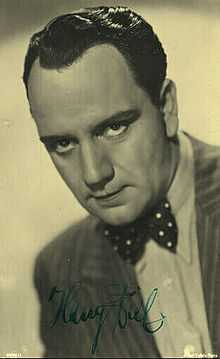Harry Piel
| Harry Piel | |
|---|---|
 autographed photo, date unknown | |
| Born |
Heinrich Piel 12 July 1892 Düsseldorf, Germany |
| Died |
27 March 1963 (aged 70) Munich, Bavaria, Germany |
| Occupation | Actor |
| Years active | 1912-1953 |
| Spouse(s) | Dary Holm |

Born Hubert August Piel, Harry Piel (12 July 1892 Düsseldorf – 27 March 1963) in Munich, Germany was a prolific German actor, film director, screenwriter and film producer who was involved in over 150 films.
Piel became a director in 1912, turning out such box-office successes as Mann Gegen Mann (1928), Achtung! - Auto-Diebe! (1930) and Artisten (1935). His last directorial effort was 1953's Gesprengte Gitter (Elephant Fury, aka Panic), which he also produced, wrote, and starred.
Biography
After attending elementary school in Benrath and High School, Piel became a cadet in 1909 on a sailing ship, the Grand Duchess Elizabeth. In 1911, however, he finished his cadethood and moved to Berlin in 1912 where he created the "Art Film Publishing House Company" and made, as a director, screenwriter and producer, his first feature Black Blood (1912) with Curt Goetz in the lead role. Further films followed, based on adventure and action.
Soon Piel received the nickname "the dynamite director" because of his penchant for including explosion sequences in his films. These were authentic: Piel had befriended a demolition engineer who was often commissioned to dynamite bridges and other condemned structures slated for demolition. The engineer notified Piel of these assignments in advance: Piel filmed the explosions, then inserted the footage into his films.
In 1915, Piel became too bored with just standing behind the camera and he started to act. The first film with him as a leading actor, The Large Bet (Die Grosse Wette), was a Science Fiction adventure, where he had to deal with robots. Into Under Hot Zone (Unter heißer Zone, 1916) included for the first time scenes with wild animals, which were used by him afterwards in other films, and partly trained by him.
This was followed by a number of films between 1918–1919, in which he played the detective "Joe Deebs" eight times and with the film To the Large Unknown Quantity (1919) began to be credited by the name "Harry Peel" internationally.
In 1927 he cast himself in a double role with Marlene Dietrich together in the film His Greatest Bluff. Also in 1927 Piel married the actress Dary Holm (1897–1960), who appeared in several of his films
In 1930 he directed the comedy Him or Me (1930), but still had many successful adventure films to follow, such as Shade of the Underworld (1931), Johnny Steals Europe (1932), The Ship Without a Port, The Call of the Jungle (1935) and His Best Friend (1937).
In 1933 Harry Piel became a patron member of the SS and also joined the NSDAP.[1]
Then however difficulties began with the Nazis, and his film "Panic" (1940–43) was banned for showing too-realistic air attacks. Seventy-two negatives of his films, nearly all his silent movies, were destroyed in an air attack. After the collapse of the Third Reich, Harry Piel, who had been a sustaining member of the SS, and had at first concealed this, was sentenced to six months detention and five years professional disqualification. After his denazification, he founded "Ariel Film" in 1950 in Hamburg with which he had only moderate success.
Piel's film Panic depicted a German hero who traps wild animals in Africa for German zoos. At the film's climax, an air-raid on a German city frees the zoo animals from their cages; when they run loose in the streets, the people are terrified and only the heroic trapper can recapture the beasts. During World War II, this film was suppressed by Reich censors who did not want the German people to believe that Germany was in danger from aerial bombardments.
After one of his last films, Gesprengte Gitter (Elephant Fury, 1953), Piel withdrew from movie-making business and died ten years later in 1963.
Filmography
width="50% valign="top"|
|
width="50% valign="top"|
|
References
- ↑ Ernst Klee: Das Kulturlexikon zum Dritten Reich. Wer war was vor und nach 1945. S. Fischer, Frankfurt am Main 2007, p. 457.
- Gerald Ramm: Das märkische Grabmal. Vergessene Filmlegenden zweier Drehorte. Woltersdorf 1997, p. 158, ISBN 3-930958-06-6 (in German)
External links
- Harry Piel at the Internet Movie Database
- Photographs and bibliography
- Düsseldorf Europa Palast Cinema showing "Der Dschungel ruft" (1935)
|